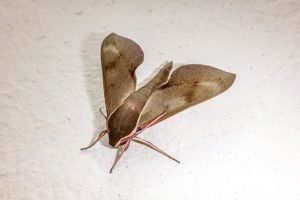
Hello! Of all my classmates, I still only communicate with Alenka. She now works in the city and lives in her own apartment.
Usually we tell each other funny stories, and recently she turned to me for help.
A mole appeared in her apartment. And Alenka is very kind to order and cleanliness in her home. I shared with her a great way to fight against moths. Want to learn how to get rid of moths in an apartment? How to prevent its occurrence? Then read on. There is a lot of useful information.
The content of the article:
How to get rid of a moth?
Moths (lat. Heterocera) - the collective name for relatively small insects from the order Lepidoptera (butterflies (Lepidoptera)).
Eating keratin, the larva leaves behind its vital products, thereby spoiling the product. Of course, the moth larva is not able to eat an entire fur coat or carpet, but it is not a problem for her to permanently ruin the presentation of the product, because one larva can easily make a through hole in an ordinary woolen or half-woolen sweater in just a day!
Caterpillars (larvae) of the moth are capable of digesting not only keratin, but also other difficultly soluble substances. Therefore, in addition to keratin, they can also feed on technical felt, which is used for heat and sound insulation, bristles, feathers, fur, leather, dried meat and fish, book bindings, museum collections, etc.
In search of food, moth caterpillars can gnaw through the pathway in materials that they cannot develop in (cotton, silk, synthetic fabrics).
I want to note that you need to fight not so much with butterflies as with laid eggs, which they lay and caterpillars, which subsequently emerge from them, because it is the caterpillars that do all the damage to the products. At one time, a female moth lays up to 100 eggs.
It is important to know that moth butterflies do not like sunlight and prefer to live in dark and secluded places, for example, in a closet with clothes or in a linen dresser.
Hatched larvae (or caterpillars) also prefer not to be seen by humans and live modestly in dark corners, usually in the woolen things themselves, where it is almost impossible to detect them. Or it is possible, but only after they, with great appetite, destroy part of the clothes to such an extent that visually not notice the problem is no longer possible.
At the moment, the number of species of moths according to various sources, there are about 40 pieces. Some are agricultural pests, others domestic. The most famous domestic pests are fur moth, clothes moth, furniture moth, and grain moth. Of the agricultural pests, it is especially possible to distinguish a barley moth, as well as rye, cabbage and apple moth.
Kinds
Fur moth (Tinea pellionella). The insect is shiny clay-yellow in color, the front wings in front of the middle are often with two small dark points and with one, larger, behind the middle. The lower wings are light gray, with a yellowish sheen, in a span of 15-16 mm. It feeds mainly on clothing made from natural material.
Caterpillars are white, vermiform, almost glabrous, with eight very short abdominal legs, with transparent skin through which the contents of the stomach are visible; brown head. The caterpillar attacks mainly furs, lives in a portable case and gnaws all the hair on its way, regardless of whether it eats them or not.
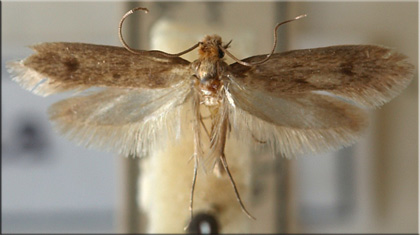
Clothes moth (Tinea tapetiella). Larger compared to the fur coat - 20-22 mm in scope. Fore wings at base violet-brown, from the middle light yellow, with a violet-brown speck at the apex. The head fluff is white.
The worm moth caterpillar is similar in appearance to the fur moth caterpillar, lives in folds or inside cloth or rag cloth, eating out more or less vast spaces that are invisible from the outside, since it mostly leaves the upper, thin layer of matter untouched; held in a stationary case.
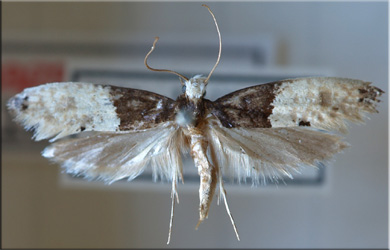
Furniture Moth (Tineola biseliella). Butterfly brilliant light yellow, with a rusty-yellow head and slightly brownish front wings at the base. Isolated in a special genus due to the absence of labial tentacles. This species, described by St. Petersburg entomologist Gummel, was later investigated by Radoshkovsky.
The caterpillars of the furniture moth feed first on the hair stuffing of the furniture, and before pupation they go outside and eat the winding paths in the furniture cover, following the direction of the patterns of matter; pupate on the underside of chairs, sofas, etc., where whole nests of their white, silky cocoons gradually accumulate.
The development of caterpillars in winter lasts about 5 months, and in summer - 2 months. Pupation begins in February. Butterfly flight continues in March, April and May; fly again in July and August.
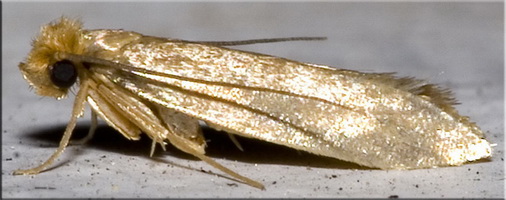
Cereal Moth (Tineola granella). Silver-white insect, with a brown changeable pattern on the front wings and with a gray abdomen and hind wings, up to 15 mm in scope. Butterflies fly twice: in spring and late summer. Each female lays up to a hundred eggs on bread grains: rye, barley, wheat, etc., gluing 1-2 eggs per grain.
Pupils here in the crevices of floors, walls, etc. It also attacks dried fruits and all kinds of seeds, and, moreover, can grow in rotten wood and in tinder funnels.
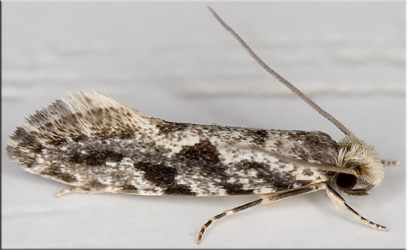
Barley moth (Gelechia (Sitotroga) cerealella). Sometimes also called cereal moth. Up to 17 mm wide. Light brown, sometimes with dark spots and a longitudinal stripe on the front wings. The hind wings are gray. Labial tentacles are long, rising above the head like horns; their last segment is shiny, black, hairless.
Butterflies fly in June and September. The former lay eggs on ears of winter bread ripening by that time (barley, winter wheat, sometimes rye). The caterpillar enters the grain and gradually eats away all its contents without touching the outer film, so that the grain seems normal from the outside.
The second generation of caterpillars develops in the same way in barns, and then the next generation of butterflies flies earlier - in March. If the grains infected with young caterpillars get into winter crops, then the development of the caterpillar in them does not stop underground, but proceeds more slowly and ends in May.

Rye Moth (Ochsenheimeria taurella). 13 mm wide, yellow-brown, hind wings whitish, brown on rim, antennae black at base. Flies in Central Russia at the end of summer and lays eggs on wild cereals and on seedlings of winter crops.
The caterpillar feeds on the core of the stem, it hibernates here and in the spring continues to eat away the stems, attacking their younger parts under the spike; the eaten ears become sick and dry. Pupils in late June in a white silky cocoon between leaves.
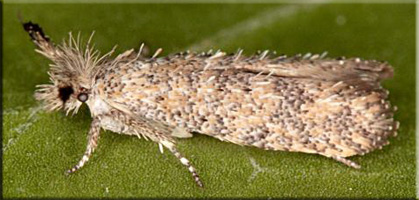
Cabbage Moth (Plutella cruciferarum). 15.5 mm wide, fore wings brownish yellow, with oblique brown stripes and along the posterior margin with a white wavy strip. Hind wings are brownish-gray. Head and back are white. Tendrils with white rings. Fly for the first time in spring.
Caterpillars are green, with brown heads, eat young leaves during July, and here in the end of July pupate in trellised cocoons. Butterflies fly a second time in early August, and during the fall a second generation of caterpillars develops, which pupate in winter.
Moth Control Methods
Heavily affected by moth products will have to be thrown away, and those in which there are few insects can be sorted out and dried in the oven by opening its door at a temperature of 60–70 ° C for 15–20 minutes. You can use a microwave for the same purpose.
The cabinet where food was stored and the moth lived, must be washed from the inside with a warm soapy solution, and then with clean water; grooves and crevices with a brush to smear table vinegar. Keep the cabinet open until it dries.
To get rid of moths, we advise you to use ultraviolet radiation in direct sunlight or a quartz lamp. Insect sunbaths lead to protein coagulation. Under the influence of direct rays of the bright sun, moth eggs die within an hour. And in very hot weather in the summer - for 30 minutes.
Affected items are treated with dichlorvos-based drugs. A more radical means of destroying moth caterpillars does not yet exist. In addition, dichlorvos is the only sure remedy against a skin eater.
Heat treatment is also detrimental to these harmful insects. If it is possible to expose the infected thing without risk to high temperature, disinsection can be carried out by boiling or steam.
Freezing also leads to the death of insects at all stages of development. The eggs and eating larvae of the skin-eaters die during the day.
Antimole drugs
The cheapest option is tablets and briquettes, which are an alloy of naphthalene and camphor. Tablets are traditionally placed in the upper part of the cabinets. Heavy pairs of naphthalene and camphor descend, preventing moth butterflies from laying eggs on their clothes.
- Antimol tablets are suspended in a cabinet (3-4 tablets per cabinet). Throw them out after two weeks.
- Desmol is an effective drug, it is also used as Antimol.
- “Molemor” can hang in the closet for six months, but you need to use no more than two records in one room.
- "Suprosol" is an aerosol anti-molar preparation.
- Supromit is a liquid preparation for the destruction of moths with a pleasant smell. They process the walls of cabinets, clothes. Valid for several months.
- Moskitol - plates against moths.
- “Anti-mole raid” - in the form of aerosol, gel and plates.
- "Trap - antimole - spray"
Advanced moth plates are free from unpleasant odors. According to manufacturers, they destroy moths and larvae, scare off carpet bugs and leather-eaters. The combat readiness of the plates can be expected within 6 months.
Sections from moths are the most civilized form of antimole preparations. They can be with the scent of lavender, mandarin and chamomile. Special sections are produced for the delicate protection of children's things. It is necessary to remove the protective tape and place the section at the top of the cabinet. The anti-molar action of one section extends to 0.5 cubic meters. m
Due to the fact that chemical preparations have different smells, sometimes not very pleasant, I recommend not to purchase such products in natural markets, or from hands, as well as products, packaging and name that at least you may raise doubts, and even more so with obscure inscriptions not in Russian.
This is primarily a safety measure, as it is not clear how such agents can affect the human body, and so that the pitch struggle does not turn into more serious problems.
Folk remedies
Our grandmothers and great-grandmothers did not know a more effective remedy for moths than naphthalene. However, as it turned out, he only scares away moth butterflies from clothes, but cannot destroy either eggs or caterpillars. In addition, according to the latest scientific data, volatile naphthalene is classified as a possible carcinogen, leading to the development of cancer in humans and animals.
Moth does not tolerate the smells of camphor and pieces of cedar wood. You can also use vinegar in the fight against moths: Pour a few tablespoons of vinegar into a hot pan, and close the pan in the cupboard. Just do this carefully so as not to harm yourself and your property with a hot pan.
Pyrethrum powder (Caucasian chamomile) can help get rid of flying moths. 3-4 grams of this powder are scattered on 1 meter of area.
Butterflies don’t like moths and the smell of tobacco, pepper, dry orange peels, strawberry soap ... Moth does not tolerate the smell of leaves of such home plants as coleus (it is also “nettle”) and geranium. Fresh leaves of these unpretentious plants are occasionally put in the wardrobe to replace the old.
However, remember that all herbal remedies serve only as repellents. They scare away moth butterflies, protecting things from the invasion of pests.
If the moth has already occupied your closet, putting a bunch of lavender into it is useless. Have to resort to chemistry.
Prevention
All groceries should be stored in tightly closed jars or, in extreme cases, well-tied plastic bags.
Larvae do not tolerate bright sunlight and fresh air. That is why things that are often “in use” are not afraid of moths. And about winter clothes sent for the summer to the closet, you need to take care in advance. Moth caterpillars start their meal with dirty and sweaty stains, completely eating away the fabric along with the dirt.
Carpet and fur coats are sprayed with Antimol Contact liquid before they are put into storage, and when the products dry, they are wrapped in plastic wrap and placed in a cupboard. This protects them from spoilage by moths for 3-5 months.
To prevent the appearance of moths, we advise you to regularly air and clean the apartment as often as possible. And also to clean at least 1 - 2 times a month upholstered furniture and carpets (most effective with a vacuum cleaner). Desirably using disinfectants, for example, monochloramine.
Pay special attention when vacuuming the processing of gaps between skirting boards and walls, in the floor, the spaces between walls, furniture and flooring. The most concentrated are the larvae of the skin-eaters and pupae of moths. Adult skin-eating beetles often accumulate in shades or on windows where they can be easily assembled with a vacuum cleaner.
- Since moths do not like the smell of cedar, fur coats or other similar products can be hung on hangers made of cedar wood, the smell of which will scare away the moth, and things will be saturated with a pleasant fresh aroma of the tree.
Giant moth
The giant female Attacus, the largest moth in the world, was found in the Eastern Himalayas. Photographer Sandesh Kadur discovered a huge moth with a wingspan of 25 centimeters.
At first, Kadur was frightened: the moth opened its wings, as if trying to attack. But overcoming fear, the photographer first took a picture, and then even took it in his hands.
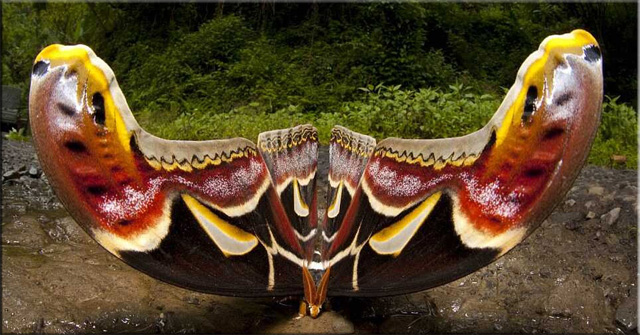
Experts say the mole is absolutely harmless. She uses a terrifying color only to scare off enemies.
These winged giants live only two weeks. And their main goal is reproduction. They simply cannot eat — they have no mouth. They live off the reserves of fat that accumulate at the caterpillar stage.
How to destroy a mole in a house
In order to destroy the moth and not give it a chance in the future to reappear in your house, you need to know what the moth loves and what it avoids or is afraid of panic.
Of the many types of moths known to science, we restrict ourselves to considering species that live in residential buildings. For the kitchen, this is a grain moth, and carpeted, felt, furniture, clothes and fur coat moths can exist quite comfortably in living rooms.
Cereal moth
In the presence of comfortable conditions - increased humidity and lack of ventilation, grain moth becomes a full-fledged mistress in the kitchen.
Having gained access to cereal cereals and their derivatives, female female moths lay eggs in large quantities on them. Small larvae hatching after a while from laid eggs with an incredible appetite eat everything edible around them: buckwheat, rice, wheat, rye, barley, flour, pasta and dried fruits.
At the end of the development phase, the caterpillar finds a secluded place in the crevices of the cabinets or behind the baseboards, creates a cocoon around itself and turns into a chrysalis, from which the moth butterfly emerges over time.
Grain Moth Fight
All types of cereals, flour and dried fruits should be stored in tightly closed containers. If it was still not possible to protect the products from moths, we study the degree of their corruption. If the cereals are pretty spoiled by larvae, we immediately get rid of them.
If the caterpillars of the moth just started their “work” and did not have time to spoil the food stocks, we carefully sort such groats in the microwave for 3-5 minutes or in the oven of a gas stove at a temperature of 700 C for 20 minutes. The oven door must be ajar.
You can destroy the eggs and larvae of the kitchen moth by subjecting the cereals to cold processing. A temperature below 00 C and half an hour will be sufficient.
All the cabinets, shelves, drawers in the kitchen are washed with warm soapy water, and then again we go through them with clean water. Each groove, each slit, each hole is greased with a brush dipped in vinegar or in saline.
After titanic work to remove the “uninvited guests”, we left in the kitchen cabinets and put twigs of geranium or lavender on the shelves, pour a handful of tobacco or peel of citrus fruit - all these smells will scare away the moth butterflies, which means we will have more eggs and larvae of this voracious insect not threatened.
Wool moth
A community of clothes, carpets, felt, furniture and fur moths, eating fur, carpets and wool, for convenience, we will call one collective name - wool moth.
They indulge in almost everything: fur, felt, wool, velvet, feathers, book bindings, wax - this is an incomplete list of what the caterpillars of a wool moth are able to eat. They live about two years, then turn into a chrysalis, from which a moth butterfly later flies.
Fighting wool moths
It is mandatory to regularly clean the apartment: we clean carpets, upholstered and hard furniture. The eggs of the moth larvae are loosely attached to the fibers and fibers of carpets and clothes, so by vacuuming or shaking out these objects, we can quite easily get rid of egg laying of insect pests.
Dry and air all things at least four times a year. Fresh air and bright sunlight are fatal to the wool moth.
We place on the shelves and in the section of the clothes cabinet, as in the case of grain moths, tobacco, citrus peels, sprigs of lavender or geranium, a piece of cotton wool moistened with fir or lavender oil.
Chemicals
Fumigation preparations in the form of tablets, plates and sections are located on the upper shelves of wardrobe and wardrobes. The active substances that make up these drugs evaporate and, dropping down, saturate the air with vapors that repel moth butterflies. Naphthalene, Antimol and Prayer have been operating for six months.
Contact means in the form of solutions and aerosols process clothes, upholstered furniture and carpets. The preparations Supromit, Aeroantimol, Suprosol, Dichlorvos and Neophos destroy both butterflies, caterpillars and eggs of harmful insects. Contact agents against moths last for three months.
It is better not to allow moth into the apartment, in advance and regularly carrying out preventive measures. And may this uninvited guest never be in your house!
How to permanently get rid of a voracious moth by effective means
If the cockroaches somehow suddenly and imperceptibly quickly gathered their belongings and left most of the houses and apartments, then the moth remains our faithful companion, continuing to feast on fur coats, sweaters, trousers, skirts, with appetite,vests and other goodies, which in our homes are more than enough.
In total, there are about 14 species of moths with an even greater number of subspecies. You and I are not entomologists, and we don’t have to know every little annoying creature by name, so all the moth that lives in our houses can be divided into two large groups:
Clothes moth - prefers to feast on, as you might guess from the name, clothes. This is a real gourmet. Look for these still. He won’t take anything into his mouth. Nylon tights, synthetic blouses? No, thank you, give us the product in kind: wool, furs, velvet, well, at worst, you can get rid of silk. Clothes moth loves coziness, comfort and tranquility of warm and dry wardrobes.
Kitchen moth - lives in the kitchen and in other warm and humid rooms with poor ventilation, where all kinds of grain crops and cereals are stored. She especially loves to feast on flour, oatmeal and buckwheat, but rice, which is significantly inferior to them in terms of usefulness, is not very attractive. Well what can I say, the lip is not a fool.
Why is the number of moths increasing?
It would seem that we are becoming more civilized and increasingly alienated from nature. So the cockroaches, poor people, could not withstand such rapid progress, but the moths didn’t care.
Yes, just this young lady really loves luxury and prosperity, and things made from natural materials are really luxury today. With the growth of well-being, purchasing power also grows, and accordingly the moth has more goodies.
Effective Ways
We drive insects out of the closet. When we see a moth, then we simply jump on some subconsciously-involuntary level and start chasing after it. There is little sense in this, to put it mildly.
And first of all, they will take up dirty sweaty stains, so the fight must begin with a thorough cleaning and washing of clothes before storage.
Caterpillars of the moth are unusually tenacious: they calmly withstand temperatures up to 0 degrees and can go without food for a month. Moth lives, on average, for about two years and can create a lot, during this time. It is because of the extraordinary vitality, endurance and fertility of a moth that getting rid of it is extremely difficult, but possible.
It should be remembered that the caterpillars of the moth do not tolerate fresh air and bright sunlight, therefore the moth is not scary for the things that we carry constantly. When cleaning warm winter clothes and fur coats for the summer in a closet, after cleaning, place them in sealed plastic bags or special covers for storing clothes with anti-milky preparations.
We release the kitchen from the "aggressor". All groceries in the house should not be stored in boxes, bags and bags, but in tightly closed jars. Although kitchen moths start up most often in products that are stored for a long time, even fresh cereals and flour need to be checked.
It is advisable to put a few cloves of garlic in a jar of flour, and place bags of pepper on shelves with cereals that will discourage the hungry moth.
From time to time, be sure to look through the stocks of cereals in time to identify something wrong and take appropriate measures. Heavily affected foods should be thrown away right away, and those that can still be saved should be sorted out, sieved and roasted in the oven or microwave for 15-20 minutes at 60-70 degrees.
Moth preparations
Pills and briquettes - cheap and cheerful. These moth control agents are an alloy of camphor and naphthalene.It is necessary to place them in the upper part of wardrobes, as heavy camphor and mothballs fall down, preventing moth butterflies from laying eggs.
Anti-grinding plates from moths, beetles and leather-eaters. The plates lack a specific unpleasant odor. Destroying the moth and its larvae, they also scare away skin-eaters and carpet bugs. They will serve you for about six months.
Moth sections are the most “civilized" chemistry. Simple and easy to use. Often have a pleasant aroma of chamomile, lavender or mandarin. Fastened with a special sticker to the inner wall of the cabinet. The validity period is 4-6 months, and the impact area is about 0.5 cubic meters.
Despite the fact that on sale you can find sections from moths for the delicate protection of children's things, do not forget about the toxicity of any chemical repellents and do not exceed the permissible number of sections in a particular room.
How to get rid of folk remedies
In addition to toxic chemical anti-moth drugs, many of which are powerful allergens and carcinogens, safe natural grandmothers can be used to combat moths.
Put fragrant bags of dry lavender or cotton swabs soaked in lavender or fir essential oil in the cupboards. Moth and smell of tobacco, pepper, orange peel and strawberry soap will not please you. Get geranium or coleus on the windowsill and you will always have at hand natural remedies for moths. A pair of fresh leaves will protect you from moth butterflies.
But nevertheless, do not forget that folk remedies are more likely to be preventive, because they, first of all, scare away moth butterflies, and they will have to cope with the caterpillars with chemistry, so check your food and clothing supplies regularly and conduct preventive measures in a timely manner.
How to get rid of a moth once and for all
Dry food products most often suffer from food (grain) moths. Nests are in stocks of flour, nuts, dried mushrooms, dried fruits and various cereals. Indeed, for such a moth, the most important thing is a warm place and lack of ventilation.
First you need to sort out all the stocks and pour the products into tightly closed cans, or place them in plastic bags, and tie them well.
If the moth has not yet managed to settle in supplies, but only starts to start there, such products should be carefully reviewed and the source of infection removed.
How to remove moth from cereals and dry foods. After you throw away the nest of moths, in dry products it looks like lumps of web with larvae and caterpillars.
Products (cereals, dried fruits, mushrooms and nuts) must be dried in a microwave or oven. It is better to use an oven. The products are placed on a baking sheet and for 20 minutes, at a temperature of 70 ° C, dried with an open door. Then placed in a tightly closed container.
The next step in the question of how to get rid of moths in the kitchen is to disinfect the shelves in the closet where the infected products were. To do this, it is necessary to prepare a soap solution, which thoroughly wash each shelf and cabinet doors. Then do the same operation, but with clean running water.
Cereals and dry foods are best stored in glass or metal cans with tight-fitting lids.You can also put garlic cloves, orange skins, or young walnut leaves on the shelves.
For a more effective repellent of the pest, the cloves of garlic can be placed in a container with cereals and dry products.
There are special traps for moths, they can be purchased at grocery stores and supermarkets. They look like a triangular box with a sticky substance inside.
Do not stock up on too many dry foods. If you buy cereals or flour in stores, then put food in the freezer for several hours at home. Or even store the cereals in the refrigerator, so you definitely get rid of the pest. Perform a spring cleaning at least once a month in storage cabinets.
How to remove moles in an apartment
Unlike kitchen moths, which start mainly in the warm season, indoor moths live in apartments all year round. Finding a nest of such a moth is a difficult task.
But everything is possible if you make an effort and ingenuity. A moth eats everything in its path, and even if you hid your favorite things in a synthetic fabric or plastic bags, this is not an obstacle for a moth, and it will easily gnaw on the road to dainty.
How to get rid of a moth and its larvae? First you need to find the source of the infection - sort out all the things. If there are larvae on the clothes, they must be shaken out the window, and things should be hung out in the fresh air and bright sun. Also, a sharp temperature drop kills harmful larvae.
Put things in a plastic bag and place in the freezer for 20 minutes, and then warm at room temperature, repeat the procedure five times. If a moth is wound up on leather, fur or wool products, it can be removed only with dichlorvos-based preparations. This is the only effective remedy.
The most common location for domestic moths is the closet. How to get rid of moths in the closet. For this, special anti-pest agents are used. Naphthalene is often used, but in addition to protecting against moths, it also harms humans. After all, it contains harmful components that lead to unpleasant diseases. Therefore, it is not recommended to use it.
When buying a remedy for moths, choose one that does not include naphthalene. Now the market is clogged with modern anti-moth products, it can be tablets, briquettes or plates. They are placed in a closet and changed every six months.
In order not to wonder how to get rid of a moth, it is necessary to prevent its appearance again. All woolen things in the closet should be washed, and fur coats and fur coats treated with anti-milking agents. Also, in the warm season, fur products need to be stored in special covers, or wrapped in thick paper soaked with moth detergent.
You need to protect not only the products, but also the cabinet itself. To begin, carry out a general cleaning, vacuum all the secluded places in the cupboard, and wipe all the shelves with a solution based on vinegar (3 tablespoons of table vinegar per 1 liter of water). And let it dry thoroughly, after which you can fill the closet with clean and processed clothes.
How to remove moth in the closet with folk remedies. Not everyone likes to use chemicals, because natural ingredients are much more beneficial for humans.Therefore, in a cupboard put dried bouquets of geranium or lavender. Some make pads with cloves and lavender and place them on shelves in the closet.
Moth does not like cleanliness and fresh air, so the apartment needs to be aired and cleaned as often as possible. In addition to cabinets, moth can be found both in carpets and in upholstered furniture. The most effective way to kill moths is to vacuum the carpets and furniture at least twice a month.
Particular attention should be paid to cleaning skirting boards. Vacuum thoroughly all the cracks, especially in the dark corners, because the moth nests are most often found there. Also, larvae can be in the corners of windows or inside shades.
Moth is afraid of high and low temperatures. Therefore, to get rid of the larvae, it is enough to freeze or warm them. If the fabric is burned out, you can put the item in the freezer, or use the steam to destroy the pest. But you need to remember that at low temperatures, larvae and eggs die during the day.
Using chemicals
Now in supermarkets and stores you can find a lot of anti-grinding agents. Here, and plates, and tablets, and briquettes, and sprays even have anti-grinding sections. Plates, briquettes and tablets are considered the most economical. They include an alloy of naphthalene and camphor. Such tools (plates, briquettes, tablets) are placed on the upper shelves of cabinets and cabinets.
Heavy camphor and naphthalene vapors gradually descend, thus preventing the reproduction of moths. Funds are valid for six months. This method is really effective, but in addition to destroying moths, it can harm the human body. Before use, the tablet or plate must be wrapped in gauze.
Before use, the protective tape is removed, and the section is placed in the upper corner of the cabinet. You can choose the aroma of such a section (lavender, mandarin, chamomile). If you have a small child, you can purchase a special section to protect children's clothing.
One anti-mole section distributes 0.5 m3 pairs of killer pairs for moths and can serve for six months. Then replace the device. Using any chemical agent, you need to read the instructions in detail to reduce the risk of harmful substances entering your body.
With the help of folk remedies
The use of naphthalene, to relate to folk remedies, our great-grandmothers also resorted to it. But how would they be disappointed to find out that naphthalene repels only adult moths, and larvae and caterpillars do not suffer a bit.
Naphthalene also produces saturated steam, from which cancer diseases can develop, as using folk remedies you need to remember that they scare away only a new moth of animals, and in humans.
Therefore, using such a tool is not recommended. Before. If you have got larvae and caterpillars, only chemicals will help.
As you know, the moth does not tolerate pungent odors, so natural lavender essential oil is used to repel it. A piece of cotton wool or gauze is impregnated with such oil, and placed in a cupboard. You can also hang dry lavender branches wrapped in gauze.
In addition to lavender, the moth does not tolerate other odors: garlic, orange, strawberry soap, kerosene and tobacco. Therefore, you can make small rag bags with these components, and put them on shelves in the cabinet. Garlic is most often used to control grain moths.
How to remove moth using indoor plants. Coleus and fragrant geraniums are very unpretentious helpers in the fight against moths. To grow such a plant is simple, and it will bring not little benefit, because its aroma cannot tolerate moths. Since you do not put the flowerpot in the closet, tear off a few leaves from the bush and put them on the shelves when the leaves are dry, refresh them.
If you use plants and essential oils in the fight against moths, remember that they only repel moths and do not destroy its larvae and eggs.
Tips for Avoiding Her Appearance
In order to avoid the appearance of moths, you need to regularly air the apartment. Perform deep cleaning at least once a month. Wipe walls, shelves, furniture, windows and chandeliers. Moth can start where you least expect to see it. For example, on the spine of a book, or in old rubbish hidden on a mezzanine.
Also stocking up with dry foods, don't shop for a year. Buy everything in moderation, and store cereals in a glass or metal dish with a tight-fitting lid. It is better not to use plastic bags for storage, because they can very easily get a pest.
In order not to think about how to remove moth from dry products, buy flour and cereals of good quality. Because cheap cereals contain dust, which makes it easier to start a mole. After purchasing, it is better to put dry foods in the freezer for an hour, so you will avoid the appearance of moths.
Many people think that the moth does not like dirty things, this is a huge mistake. In dirty things, moles start up faster, and consume such things with great appetite. Therefore, only clean, washed items should be in the closet. Notice, moths never have clothes that you often wear, her favorite treat is things hidden away.
Another effective tool is kerosene, but its smell can disable not only the moth, but also the person. Therefore, it is not recommended to use it, although in the army this is how the pest is poisoned.
To prevent the appearance of moths in dark corners, on your favorite clothes or on book roots - use aerosols. Before using them, read the instructions and spray the product in the right places. Most often they are applied to furniture upholstery, a bookshelf, clothes, dark corners and chandeliers.
Also do not forget about upholstered furniture, folding sofas, mezzanines and pantries. Moth can start where there is dust and dirt. Therefore, carefully clean the premises, do not leave any places uncleaned, because it is in them that moles can be brought on. Folding furniture needs to be vacuumed not only from above, but also inside, paying due attention to the corners.
In order not to worry about how to get rid of domestic moths, all things hidden in sofas, pantries or mezzanines should be packed. It is also better to immediately process things with special anti-grinding agents. If you are not a proponent of chemistry, use folk remedies. And wash the places themselves with soapy water, and ventilate. After put things, and lay out the branches of lavender.
During cleaning, do not forget to vacuum the twisted carpets, because they most often contain a source of infection. Also ventilate winter clothing at least once a month in the warm season. If you follow all the tips and monitor the cleanliness in your apartment, you can not think about how to get rid of the moth, but also prevent its appearance.
Fighting moths at home
Moth is a rather annoying and nasty insect that creates a lot of problems and harms things and products. Today, there are about 30 species, each of which larvae lays in certain places, from clothing to cereals.
Some try to kill them, but as practice shows, there is no sense from this, because they destroy mainly males, which do no harm to things, but females lay larvae in different places and our main goal is to get rid of them, but they usually hide in different places. How to deal with such insects.
An excellent means of struggle is the dry grass of lavender, which should be placed in small canvas bags and put in things, cabinets in the pantry, where you store cereals and flour, on which the moth is so greasy. The moth does not tolerate the smell of lavender and will quickly disappear.
Also, a moth cannot live where you lay out dry crusts of mandarin or orange, small bouquets of twigs and leaves of walnut, tobacco and bitter wormwood.
Make it a rule every summer to take out all the clothes to dry and always under the sun - a moth really does not like sunlight and immediately dies. The frost also has the same effect - take your clothes out in the winter to the street or an open balcony and in an hour, all the moth will die from a sharp temperature drop.
If you find clothes on which there is a nest with moth larvae, then in winter we take it to the balcony and then wash it in hot water or put it in the freezer if it goes in the summer. Ventilated items should be packaged in plastic bags and shipped with citrus crusts or lavender.
Love to admire indoor plants - put geraniums, which destroy the moth. Put flower pots close to the closet with things and in the kitchen.
Buy lavender oil in a pharmacy, soak swabs or pieces of material in it and wrap them with polyethylene, which they pierce in several places with a thick needle and place in a place free from things in the closet.
The essential oil will begin to evaporate and saturate the air in the cabinet and the mole will die. The action of the swab lasts two weeks, then it should be changed to fresh.
leave a comment